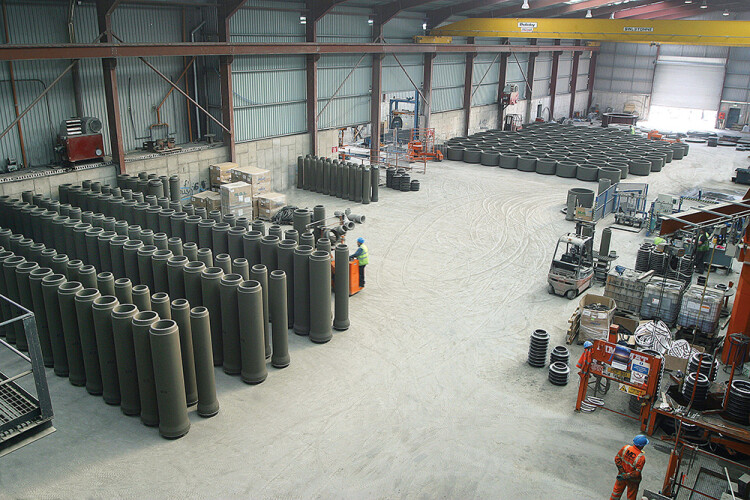The idea of making concrete that contains no cement seemed nonsensical until recently, but suddenly it’s as if everybody is at it.
Precast concrete manufacturer FP McCann, based in Knockloughrim, Northern Ireland, is the latest to announce that it is turning its back on ordinary Portland cement. Last month it launched a new range of precast manhole rings and pipes made with so-called Earth-Friendly Concrete (EFC) from Australian company Wagners.
Cement has become an embarrassment for the construction industry since it became known that its production is responsible for about 8% of global carbon emissions. Hence over the past few years cement and concrete producers have been working tirelessly to find ways of mitigating their environmental impact and salvaging their reputations.
The result is a swathe of new concrete formulations designed to minimise or even eliminate cement content.
The EFC chosen by FP McCann uses “a geopolymer low-carbon binder that is formed from the chemical activation of fly ash and ground granulated blast-furnace slag [GGBS]” instead of cement.
The company claims that replacing the cement with this binder, made using materials from recycling streams, reduces the overall environmental impact and CO2 emissions of the concrete by as much as 80%.
As an added bonus to its low carbon credentials, EFC is said to be capable of achieving strengths similar to traditional concrete and, thanks to the chemistry of the geopolymer binder, providing improved durability in many aggressive environments.
For those who are serious about reducing their carbon emissions, using a low-carbon product developed by an Australian firm might be problematic: think of all those carbon-miles.
However, Wagners has a licence agreement in the UK with London-based Capital Concrete, a Breedon subsidiary, to which it currently supplies off-the-shelf chemicals for mixing EFC on site. By setting up its own production facilities in the UK, Wagners expects to bring costs down and get closer in price to conventional cement-based concrete.
Probably the best-known ‘cement-free’ product currently available in the UK is Cemfree, developed by Cambridgeshire firm DB Group and launched in 2015. This is an alkali-activated binder made up of 95% GGBS and 5% activator.
Earlier this summer piling firm Aarsleff Ground Engineering carried out the world’s first trials of precast concrete piles, made by sister company Centrum Pile, using Cemfree.

The aim of this trial is to test the durability of concrete made with these alkali-activated cementitious materials (AACMs) in sulphate-rich ground conditions and asses the market potential of piles made using it.
An industry stakeholder group, A3CM, has been set up to support the development of these products.
And Aarsleff isn’t the only piling contractor to try out Cemfree. Late last year Keltbray Piling used Cemfree in the mix for secant wall and bearing piles on Taylor Wimpey’s new residential development in Mount Pleasant, London.
Cemfree also made the news last year when Milestone Infrastructure, part of M Group Services, laid kerbs made with the stuff on Histon Road in Cambridge.
The cement industry is itself rising to the challenge by formulating products less likely to damage the environment. Two years ago Cemex brought out what it claimed was the “UK’s first net-zero ready-mixed concrete”, called Vertua.
Cemex has not disclosed what Vertua is made from, other than it incorporates a new geopolymer chemical developed in firm’s Swiss laboratory. Not content with reducing its contribution to global warming, Cemex has made the audacious claim that customers can, if they wish, make their Vertua order carbon-neutral.
For a price, they can have the material’s residual carbon emissions offset thanks to an arrangement with offsetting consultant Natural Capital Partners.
Most, if not all, of these low-carbon or zero-carbon concrete products use AACMs – invariably GGBS or fly-ash. These materials are nothing new when it comes to concrete mixes. In the past they were used extensively for low- to medium-strength mixes mainly because they were industrial by-products and far cheaper than Portland cement.
But with anxiety over the climate emergency now at fever pitch, the realisation that you can make concrete without burning limestone and pumping tonnes of carbon into the atmosphere has made AACMs more marketable than ever.
But fly-ash is what you get from burning fossil fuels in coal-fired power stations. And GGBS is the stuff left over from smelting iron to make steel.
Burning coal and smelting steel both release huge volumes of carbon dioxide into the atmosphere. But if you’re in the concrete industry, that’s not your problem – someone else is emitting the CO2, so you don’t have to.
Got a story? Email news@theconstructionindex.co.uk



